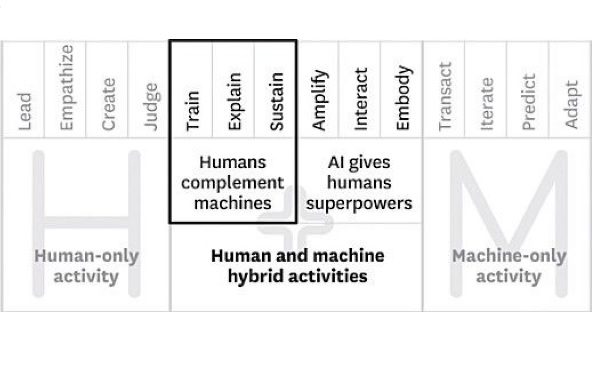I am currently exploring this idea in a paper
Could your personality decide how you can collaborate with AI in future jobs?
I am a strong believer in a mode where humans and AI work together and collaborate
I also believe that if we can master this skill, we can bring manufacturing jobs back from offshore destinations
In the book Humans + Machines – Reinventing work in the age of AI: Daugherty and Wilson (2018) propose a model for humans and AI working together based on the idea of identifying the ‘missing middle’. The missing middle represents areas where humans and AI collaborate and comprises of two sections:
where humans complement machines and
where AI gives humans superpowers.
The authors identify subcategories in these models that I briefly explain below.
The authors call for process re-engineering to rethink business processes implemented as a hybrid human-machine model.

Source: Daugherty and Wilson (2018)
Functions where humans complement machines
- Trainers train the algorithms by performing tasks such as Clean data for upload; Discover relevant data and data streams; observe machine decision making; tag data; train AI on language, gesture, empathy; Have machine observe interactions; Correct errors, reinforce successes
- Explainers: test, observer and explain the algorithms. They also explain and interpret machine learning outputs to stakeholders.
- Sustaining: Involves overseeing the algorithm, setting limits, ethical and legal compliance, Ensure data quality, check output quality, consider societal and business impact. The function of sustaining also involves: Explainability: humans could help in explaining the intermediate steps of an algorithm), Accountability: explicitly identifying which decisions are delegated to machines and which decisions require human intervention, and who is accountable in either case) Fairness: Ensures that AI solutions are balanced and not biased, protection against data bias, an understanding of why decisions are made.
Functions where AI gives humans superpowers
- Amplifiers complement algorithms by matching, recommending and patterning. Algorithms amplify the capabilities of humans by various means such as automating repetitive or low-level tasks; suggesting alternatives, prioritising resources etc. Specifically, algorithms are good at large scale pattern detection which include tasks like identify trends in real time, personalising offerings, identifying anomalies, categorising and routing data on scale etc.
- Interact: The ability to interact allows algorithms to take over many of the routine interaction tasks with people and allows human workers to focus on higher order activities. Tasks which algorithms could perform include automated question and answers; voice-driven conversations
- Embodiment: works with AI in physical spaces. Activities include Self-navigate around humans and autonomous machines; Extend sight, hearing or touch; Assist on exact, arduous, or routine physical work
Now, based on this, can we think of personality traits in humans that could be suitable for jobs based on the above?
So, think of Myers Briggs theory for personality types
Myers-Briggs theory is an adaptation of the theory of psychological types produced by Carl Gustav Jung. It is based on 16 personality types, which Jung viewed as stereotypes. They act as useful reference points to understand your unique personality (Jung 1957, p. 304). At the heart of Myers Briggs theory are four preferences. Do you prefer to deal with:
- People and things (Extraversion or “E”), or ideas and information (Introversion or “I”).
- Facts and reality (Sensing or “S”), or possibilities and potential (Intuition or “N”).
- Logic and truth (Thinking or “T”), or values and relationships (Feeling or “F”).
- A lifestyle that is well-structured (Judgment or “J”), or one that goes with the flow (Perception or “P”).
In Myers Briggs theory, for each pair you prefer one style more than the other. You combine the letters associated with your preferences to get your Myers Briggs personality type. For example, having preferences for E, S, T and J gives a personality type of ESTJ.
The first pair of styles is concerned with the direction of your energy.
The second pair concerns the type of information/things that you process.
The third pair reflects your style of decision-making.
The final pair describes the type of lifestyle you adopt.
When you put these four letters together, you get a personality type code. Having four pairs to choose from means there are sixteen Myers Briggs personality types.
So, the question I am working on is: Can we design a similar model of personality types so that we can then identify which personality type is suited for which function in the ‘missing middle’
If we could get this right, we could change the nature of jobs and the nature of the workforce
AI would be a friend instead of a threat to employment
Ironically, COVID-19 gives us the opportunity to explore these ideas
I should be able to publish more when we have more data from our paper
